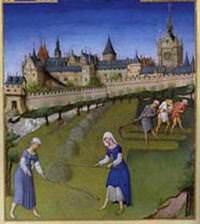The Means of Agricultural Production: Muscle and Tools
Bryer, Anthony
The Economic History of Byzantium: From the Seventh through the Fifteenth Century, Dumbarton Oaks Research Library and Collection Washington,D.C. (2002)
Abstract
The principal means of Byzantine production was the muscle of its peasants. The Byzantine state, its administration, defense, even patronage of its arts, eventually depended upon how efficiently it exploited this simple resource. So did the peasant: in the absence of a work ethic, he had an approach to manual labor, which was to avoid it beyond the immediate needs of domestic autarky, unless coerced by taxation, tithe, or impost, or (more rarely) lured by a market for surplus that lay within a day’s walk of a burdened beast or woman. In turn, the peasant knew how to exploit his muscle by implements, which offer almost infinite leverage. A simple crowbar gives a mechanical advantage of factor 4, but given the right gearing a child can, in theory and with his little finger, perch an 800-ton Egyptian obelisk on four brazen blocks in the Hippo- drome of Constantinople. In fact, it took the men of Emperor Theodosios I a month to erect it in 390. The question is where and why the line of technological stimulus stops? For example, the peasant did not just know that a crowbar gave him an advantage of four, but that any tool was more efficient if iron-shod—and even wooden imple-ments need iron to shape them.
The Means of Agricultural Production: Muscle and Tools
Bryer, Anthony
The Economic History of Byzantium: From the Seventh through the Fifteenth Century, Dumbarton Oaks Research Library and Collection Washington,D.C. (2002)
Abstract
The principal means of Byzantine production was the muscle of its peasants. The Byzantine state, its administration, defense, even patronage of its arts, eventually depended upon how efficiently it exploited this simple resource. So did the peasant: in the absence of a work ethic, he had an approach to manual labor, which was to avoid it beyond the immediate needs of domestic autarky, unless coerced by taxation, tithe, or impost, or (more rarely) lured by a market for surplus that lay within a day’s walk of a burdened beast or woman. In turn, the peasant knew how to exploit his muscle by implements, which offer almost infinite leverage. A simple crowbar gives a mechanical advantage of factor 4, but given the right gearing a child can, in theory and with his little finger, perch an 800-ton Egyptian obelisk on four brazen blocks in the Hippo- drome of Constantinople. In fact, it took the men of Emperor Theodosios I a month to erect it in 390. The question is where and why the line of technological stimulus stops? For example, the peasant did not just know that a crowbar gave him an advantage of four, but that any tool was more efficient if iron-shod—and even wooden imple-ments need iron to shape them.
the peasant knew how to exploit his muscle by implements, which offer almost infinite leverage. A simple crowbar gives a mechanical advantage of factor 4, but given the right gearing a child can, in theory and with his little finger, perch an 800-ton Egyptian obelisk on four brazen blocks in the Hippo- drome of Constantinople. In fact, it took the men of Emperor Theodosios I a month to erect it in 390. The question is where and why the line of technological stimulus stops? For example, the peasant did not just know that a crowbar gave him an advantage of four, but that any tool was more efficient if iron-shod—and even wooden imple-ments need iron to shape them.
Click here to read this article from The Economic History of Byzantium
Subscribe to Medievalverse
Related Posts